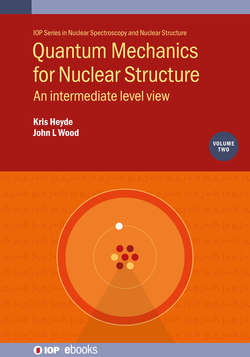Читать книгу Quantum Mechanics for Nuclear Structure, Volume 2 - Professor Kris Heyde - Страница 12
На сайте Литреса книга снята с продажи.
1.4 Matrix representations of rotations in ket space
ОглавлениеWe are now in a position to obtain matrix representations of rotation operators in ket space. For a rotation about an axis nˆ through an angle ϕ (cf. Volume 1, chapter 10),
D(R)=D(nˆ,ϕ)=exp−iJ⃗·nˆℏϕ,(1.37)
the matrix elements of D(nˆ,ϕ) are
〈jm′∣exp−iJ⃗·nˆℏϕ∣jm〉≔Dm′m(j)(nˆ,ϕ),(1.38)
where j′=j is explicitly incorporated: this is because
Jˆ2D(R)∣jm〉=D(R)Jˆ2∣jm〉,(1.39)
∴Jˆ2D(R)∣jm〉=j(j+1)ℏ2D(R)∣jm〉,(1.40)
which follows from the general relationship [Aˆ,exp{Aˆ}]=0. This is sensible because rotations cannot change the length of a vector. Thus, the matrix representation of D(R) has the form:
D(R)↔D(0)0000D120000D(1)0000D32⋱(1.41)
and we can discuss the D(j) individually.
The Euler angle parameterisation leads to a simplification when one considers a matrix representation:
Dm′m(j)(α,β,γ)=〈jm′∣e−iJˆzαℏe−iJˆyβℏe−iJˆzγℏ∣jm〉;(1.42)
but,
〈jm′∣e−iJˆzαℏ=〈jm′∣e−im′α,(1.43)
∴Dm′m(j)(α,β,γ)=e−i(m′α+mγ)〈jm′∣e−iJˆyβℏ∣jm〉,(1.44)
i.e. only the ‘Jˆy’ rotation is non-trivial. We define
dm′m(j)(β)≔〈jm′∣e−iJˆyβℏ∣jm〉.(1.45)
The Dm′m(j)(R)′s (R=nˆ,ϕ or α,β,γ) are called Wigner functions. They tell us how much of ∣jm〉 rotates into ∣jm′〉 under the action of R:
D(R)∣jm〉=∑m′∣jm′〉〈jm′∣D(R)∣jm〉,(1.46)
where the completeness relation has been used.
We are now in a position to obtain explicit matrix representations of D(R), the so-called Wigner matrices:
D(0): This is trivial. It is the 1 × 1 matrix (1).
D(12): This is a 2 × 2 matrix and can be evaluated from the properties of the Pauli spin matrices. ConsiderD12(nˆ,ϕ)=exp−iJ⃗12·nˆℏϕ=exp−iσ⃗·nˆϕ2.(1.47)Then, expanding the exponential:D12(nˆ,ϕ)=Iˆ−iϕ2σ⃗·nˆ−12!ϕ22(σ⃗·nˆ)2+i3!ϕ23(σ⃗·nˆ)3+⋯.(1.48)But, from equation (1.36),(σ⃗·nˆ)m=Iˆ,meven,(1.49)(σ⃗·nˆ)m=(σ⃗·nˆ),modd,(1.50)∴D12(nˆ,ϕ)=Iˆ1−12!ϕ22+⋯−iσ⃗·nˆϕ2−13!ϕ23+⋯,(1.51)∴D12(nˆ,ϕ)=Iˆcosϕ2−iσ⃗·nˆsinϕ2.(1.52)Explicitly,∴D12(nˆ,ϕ)=cosϕ2−inzsinϕ2(−inx−ny)sinϕ2(−inx+ny)sinϕ2cosϕ2+inzsinϕ2(1.53)for an axis-angle parameterisation.
For an Euler angle parameterisationD12(α,β,γ)=Dz12(α)Dy12(β)Dz12(γ),(1.54)then using equation (1.52):D12(α,β,γ)=e−iα200eiα2cosβ2−sinβ2sinβ2cosβ2e−iγ200eiγ2,(1.55)∴D12(α,β,γ)=e−i(α+γ)2cosβ2−e−i(α−γ)2sinβ2ei(α−γ)2sinβ2ei(α+γ)2cosβ2.(1.56)Note that D(12)(nˆ,ϕ) and D(12)(α,β,γ) fulfil the unitary unimodular or special unitary form ab−b*a*, cf. Volume 1, equation (10.42), and herein section 5.10.2.
D(1) : This is a 3 × 3 matrix. It can be evaluated using a series expansion if we use its Euler angle parameterisation. FromDm′m(1)(α,β,γ)=e−i(m′α+mγ)dm′m(1)(β),(1.57)expanding the exponential in d(1):e−iJˆy(1)βℏ=Iˆ−iβℏJˆy(1)−12!β2ℏ2Jˆy(1)2+i3!β3ℏ3Jˆy(1)3+⋯.(1.58)This is greatly simplified by the following identityJˆy(1)3ℏ3=180−2i02i0−2i02i00−2i02i0−2i02i0×0−2i02i0−2i02i0,(1.59)∴Jˆy(1)3ℏ3=180−2i02i0−2i02i020−2040−202,(1.60)∴Jˆy(1)3ℏ3=180−42i042i0−42i042i0,(1.61)∴Jˆy(1)3ℏ3=Jˆy(1)ℏ.(1.62)Then, equation (1.58) reduces toe−iJˆy(1)βℏ=Iˆ+Jˆy(1)ℏ−iβ+iβ33!+⋯+Jˆy(1)2ℏ2−β22!+⋯,(1.63)∴e−iJˆy(1)βℏ=Iˆ−iJˆy(1)ℏsinβ+Jˆy(1)2ℏ2(cosβ−1).(1.64)Thus,d(1)(β)=12(1+cosβ)−12sinβ12(1−cosβ)12sinβcosβ−12sinβ12(1−cosβ)12sinβ12(1+cosβ).(1.65)
To evaluate D(1)(nˆ,ϕ) and D(j)(nˆ,ϕ) or D(j)(α,β,γ) with j>1, we must develop the theory of tensor bases of representation in ket space.
